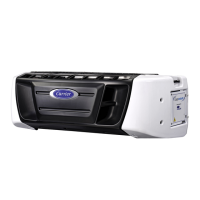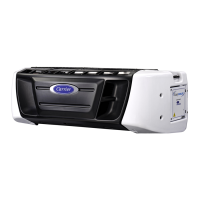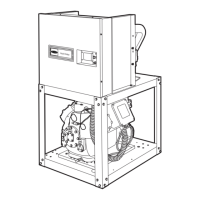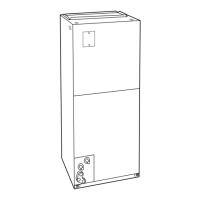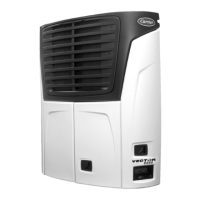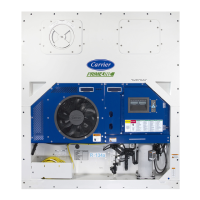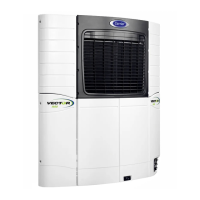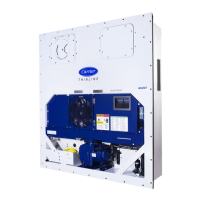Why is the evaporator coil blocked in my Carrier Refrigerator?
- DDeborah HaleySep 12, 2025
If your Carrier Refrigerator's evaporator coil is blocked, it may be due to frost on the coil (5.6) or a dirty coil (6.15).
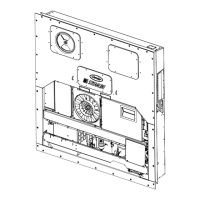
Why is the evaporator coil blocked in my Carrier Refrigerator?
If your Carrier Refrigerator's evaporator coil is blocked, it may be due to frost on the coil (5.6) or a dirty coil (6.15).
What causes low suction pressure in a Carrier Refrigerator?
If your Carrier Refrigerator's suction pressure is low, the possible causes include a faulty suction pressure transducer (replace it), a partially closed suction service valve (open it), a partially plugged filter-drier, low refrigerant charge, or a defective expansion valve. Other potential causes are no evaporator air flow or restricted air flow, excessive frost on the evaporator coil, evaporator fan(s) rotating backwards, or a malfunctioning suction modulation valve.
How to fix a Carrier Refrigerator that won't defrost automatically?
If your Carrier Refrigerator unit will not defrost automatically, it could be due to several reasons: a defrost timer malfunction (replace it), loose terminal connections (tighten them), defective wiring (replace it), a defective defrost temperature sensor or an open heat termination thermostat (replace them), or a defective heater contactor or coil (replace it).
What to do if my Carrier Refrigerator will not control?
If your Carrier Refrigerator unit will not control, the issue might stem from a defective sensor (6.22), defective wiring, a blown fuse (F1, F2, F3) (replace it), a stepper motor suction modulation valve circuit malfunction (6.20), or a low refrigerant charge (6.7).
Why won't my Carrier Refrigerator start?
If your Carrier Refrigerator unit will not start, check if the circuit breaker (CB-1 or CB-2) has tripped or if the power source is turned ON.
How to troubleshoot no evaporator airflow in Carrier Refrigerator?
If your Carrier Refrigerator experiences no or partial evaporator air flow, the possible causes include an open evaporator fan motor internal protector (6.17), defective evaporator fan motor(s) (6.17), loose or defective evaporator fan(s) (6.17), or a defective evaporator fan contactor (replace it).
What causes abnormal currents in Carrier Refrigerator?
If your Carrier Refrigerator unit reads abnormal currents, check the current sensor wiring.
What causes high discharge temperature in a Carrier Refrigerator?
If your Carrier Refrigerator displays a high discharge temperature, it could be due to a discharge temperature sensor drifting high (replace it), a failed economizer, TXV, or solenoid valve (replace it), a plugged economizer, TXV, or solenoid valve (replace it), a loose or insufficiently clamped sensor (replace it), or a failed liquid injection solenoid valve (replace it).
What causes high suction pressure with low superheat in Carrier Refrigerator?
If your Carrier Refrigerator has high suction pressure with low superheat, the superheat setting may be too low (6.14), the external equalizer line may be plugged or ice is holding valve open, or there may be foreign material in the valve (6.14).
Why do suction and discharge pressures equalize in my Carrier Refrigerator?
If the suction and discharge pressures tend to equalize when your Carrier Refrigerator is operating, it could be due to the compressor operating in reverse (5.14) or the compressor cycling/stopped (check).
| Brand | Carrier |
|---|---|
| Model | Streamline Scroll 69NT20-531-300 |
| Category | Refrigerator |
| Language | English |
General safety notices supplementing specific warnings and cautions for operation and maintenance.
Precautions for safe operation of the unit, including safety glasses and working in pairs.
Precautions for maintenance, emphasizing power disconnection and securing the unit.
Listing of specific warnings and cautions applicable to the refrigeration unit.
Controller monitoring of compressor temperatures and pressures for protection.
Information on controller alarms, their generation, and display.
Details the independent controller function for automatic or manual pre-trip testing.
Overview of the DataCORDER software for temperature recording and parameter logging.
Pre-operation inspection checklist for the refrigeration unit and container.
Instructions for safely starting and stopping the unit.
Steps for performing a start-up inspection of the unit.
Details automatic testing of unit components using internal measurements.
Troubleshooting for units that fail to start or stop intermittently.
Troubleshooting for units that run continuously during cooling operation.
Troubleshooting for units that run but do not provide adequate cooling.
Troubleshooting for units that fail to heat or provide insufficient heating.
Troubleshooting for units that fail to stop heating operation.
Troubleshooting for units that do not initiate or complete defrost cycles.
Troubleshooting for abnormal high or low pressures during cooling.
Troubleshooting for abnormal noise or vibrations from the compressor or fans.
Troubleshooting for controller issues, including loss of control or wiring faults.
Troubleshooting for lack of or restricted airflow from the evaporator.
Troubleshooting for issues related to the thermostatic expansion valve.
Troubleshooting for autotransformer issues, such as unit not starting.
Troubleshooting for water-cooled condenser and water pressure switch faults.
Troubleshooting for compressor operating in reverse, warning about internal damage.
Troubleshooting for abnormal discharge or suction temperatures.
Troubleshooting for abnormal current readings from the unit.
Description of service valves, their function, and operation.
Use of manifold gauge set for system pressure, charging, and evacuation.
Procedure for pumping down the unit to service specific components.
Recommended procedures for finding refrigerant leaks in the system.
Procedures for evacuating and dehydrating the refrigeration system.
Procedures for checking and adding refrigerant charge to the system.
Information and procedures related to the RSH105 compressor.
Step-by-step instructions for removing and replacing the compressor.
Procedures for checking and adding compressor oil.
Procedures for replacing and checking the high pressure switch.
Step-by-step instructions for replacing the high pressure switch.
Procedure for testing the high pressure switch functionality.
Instructions for cleaning and replacing the condenser coil.
Procedures for servicing the condenser fan and motor assembly.
Information on checking and replacing the filter-drier.
Description and procedures for servicing evaporator and economizer expansion valves.
Procedure for checking superheat for the evaporator expansion valve.
Instructions for removing and installing expansion valves.

